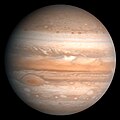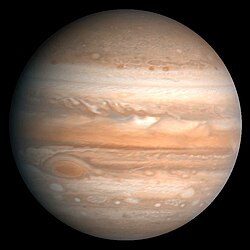Pioneer 11
Pioneer 11 var et ubemandet rumfartøj konstrueret af NASA. Det var den anden mission til udforskning af Jupiter, og den første, som udforskede Saturn og dens ringe.
På Pioneer 11 er en såkaldte pioneerplade monteret med oplysninger til udenjordisk liv om rumfartøjets oprindelse. Pioneer 10 har en tilsvarende plade.
På vej til Saturn brugte Pioneer 11 Jupiters tyngdefelt til en "gravity assist"-manøvre. Pioneer 11 passerede Jupiter 4. december 1974 i en afstand af 34.000 km, og Saturn 1. september 1979 i en afstand af 21.000 km.
Efter passagen af Saturn blev Pioneer 11 slynget ud på en bane der leder væk fra Solsystemet. Sidste radioforbindelse med Pioneer 11 var 30. september 1995.
Eksterne henvisninger
- NASA – NSSDC Master Catalog Display: Spacecraft "Pioneer 11" Arkiveret 15. august 2011 hos Wayback Machine
- NASA – The Pioneer Missions Arkiveret 30. oktober 2004 hos Wayback Machine
- Spacecraft Escaping the Solar System Arkiveret 27. april 2007 hos Wayback Machine — nuværende position og diagrammer
Medier brugt på denne side
The NASA/ESA Hubble Space Telescope has provided images of Saturn in many colors, from black-and-white, to orange, to blue, green, and red. But in this picture, image processing specialists have worked to provide a crisp, extremely accurate view of Saturn, which highlights the planet's pastel colors. Bands of subtle color (yellows, browns, grays) distinguish differences in the clouds over Saturn, the second largest planet in the solar system.
Saturn's high-altitude clouds are made of colorless ammonia ice. Above these clouds is a layer of haze or smog, produced when ultraviolet light from the sun shines on methane gas. The smog contributes to the planet's subtle color variations. One of Saturn's moons, Enceladus, is seen casting a shadow on the giant planet as it passes just above the ring system.
The flattened disk swirling around Saturn is the planet's most recognizable feature, and this image displays it in sharp detail. This is the planet's ring system, consisting mostly of chunks of water ice. Although it appears as if the disk is composed of only a few rings, it actually consists of tens of thousands of thin ringlets. This picture also shows the two classic divisions in the ring system. The narrow Encke Gap is nearest to the disk's outer edge; the Cassini division, is the wide gap near the center.Original Caption Released with Image: This processed color image of Jupiter was produced in 1990 by the U.S. Geological Survey from a Voyager 2 image captured in 1979. The colors have been enhanced to bring out detail. Zones of light-colored, ascending clouds alternate with bands of dark, descending clouds. The clouds travel around the planet in alternating eastward and westward belts at speeds of up to 540 kilometers per hour. Tremendous storms as big as Earthly continents surge around the planet. The Great Red Spot (oval shape toward the lower-left) is an enormous anticyclonic storm that drifts along its belt, eventually circling the entire planet.



